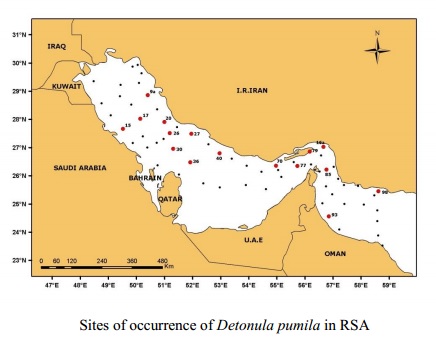Detonula pumila (Castracane) Schütt
 Division: Chromophyta
Division: Chromophyta
Class: Bacillariophyceae
Order: Biddulphiales
Suborder: Coscinodiscineae
Family: Thalassiosiraceae Lebour
Genus: Detonula Schütt ex De Toni
Scientific name: Detonula pumila (Castracane) Schütt

Cells cylindrical, close together in chains by a central thread form a strutted process and by outer tubes from strutted processes in a margin ring. One marginal labiate process is present (Throndsen et al., 2007).
Synonyms:
Schroederella delicatula Pavillard; Thalassiosira condensata Cleve;Lauderia delicatula Péragallo; Detonula delicatula Gran; Detonula schroderi Gran; Lauderia schroderi Bergon; Schroederella schroderi (Bergon) Pavillard
References:
Pavillard, 1925: p. 22, Fig. 33 (as Schroederella delicatula); Hustedt,1930: p. 552, Fig. 314 (as Schroederella delicatula); Allen and Cupp, 1935: p. 123, Fig. 26 (as Schroederella delicatula); Cupp, 1943: p. 76, Fig. 36 (as Schroederella delicatula); Crosby and Wood, 1958: p. 494, Pl. 35: 15 (as Schroederella delicatula); Hendey, 1964: p. 142, Pl. V: 4; VII: 6; Simonsen, 1974: p. 13, Pl. 6: 3; Ricard, 1987: p. 161, Fig. 133; Throndsen et al., 2007: p. 128.
Description:
Cells are cylindrical. Valves are more or less convex, sometimes almost flat, always with a depression in the middle; diameter 16-42 µm. Cells are bound in straight, more or less stiff or loose chains; intercalary bands collarlike, varying greatly in number. Mantle surface of the cell is delicately areolated, 18-20 areolae in 10 µm, sometimes very difficult to see, arranged
in a two-line system with the lines crossing each other. Marginal spines or threads are 7-8 in 10 µm. Resting spores and auxospores, unknown (Cupp, 1943).
Dimensions:
Cells length 19-22 µm; diameter 22-26 µm.
Distribution:
Cosmopolitan species, but most frequently encountered in warmer seas.
Sites of occurrence in RSA:
In Winter 2006 Cruise, this species occurred usually in small numbers at certain sites (refersites map); maximum abundance (5.4 104cells/l) was associated with the Strait of Hormuz 50 area (St. 79, 85). It has been previously reported from the inner RSA (Simonsen, 1974) and from Kuwaiti waters (Al-Kandari et al., 2009).

